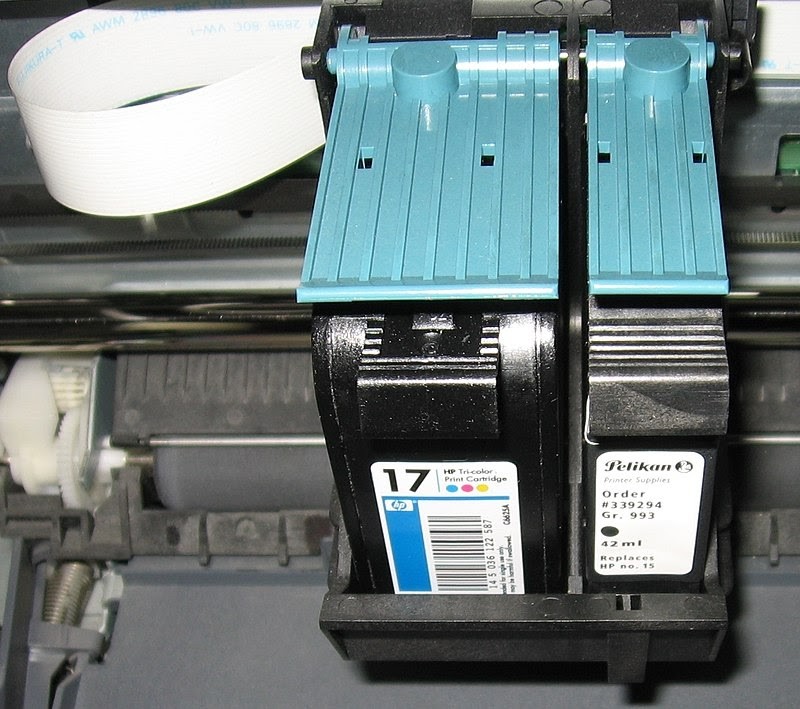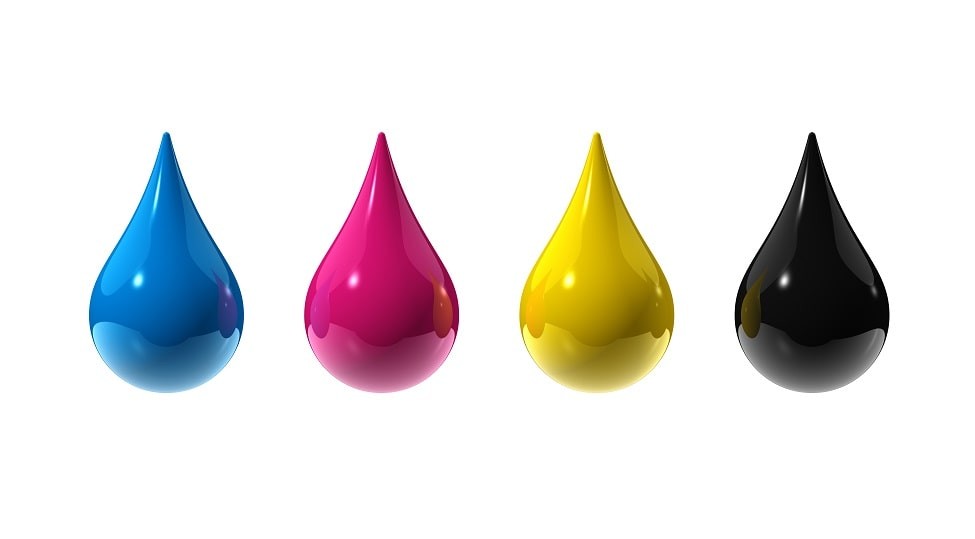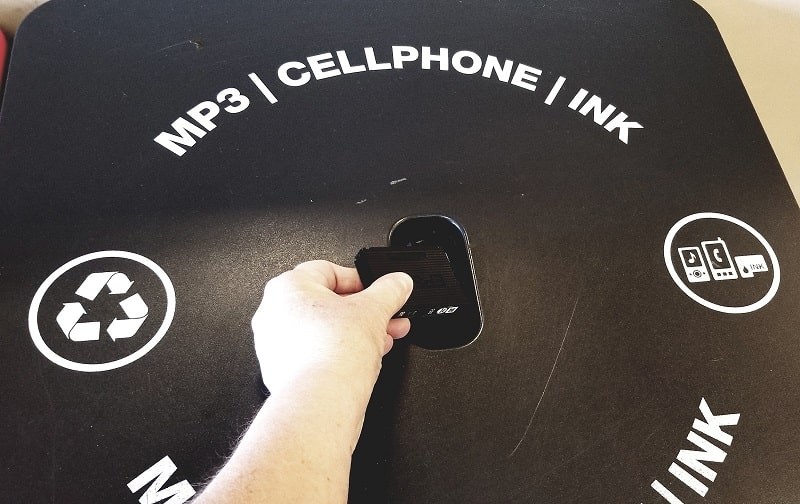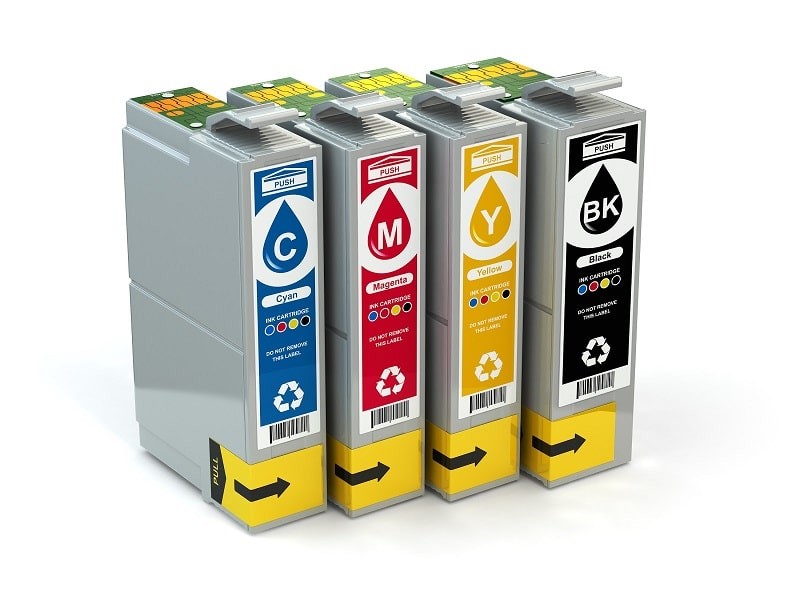Why Are Printer Inks So Expensive? It’s a common question, and the simple answer is that printer companies often make more money from selling ink cartridges than from the printers themselves; but WHY.EDU.VN dives deep to unpack this phenomenon. Understanding the reasons behind these high costs empowers you to make informed decisions and potentially find cost-saving alternatives for your printing needs. Let’s explore the ink pricing strategies and cartridge manufacturing costs.
1. The Razor Blade Business Model: Give Away the Razor, Sell the Blades
The “razor blade” business model perfectly describes the printer industry. HP, Brother, Epson, Canon, and other major printer manufacturers frequently sell printers at or below cost. Their primary revenue source isn’t the printer itself, but the replacement ink cartridges—which is why printer ink is so expensive. They know consumers will need to replenish their ink regularly, and most will stick with genuine OEM (Original Equipment Manufacturer) cartridges. This guarantees a steady stream of income for the manufacturer, allowing them to recoup the initial loss on the printer sale and generate substantial profits over the printer’s lifespan.
A genuine HP cartridge snuggles up alongside a non-OEM ink cartridge inside an HP Envy printer.
2. Research and Development: A Costly Investment
Printer companies justify the high cost of ink by citing significant investments in research and development (R&D). HP, for example, claims to invest $1 billion annually in ink R&D, holding thousands of patents related to imaging and printing, including those for ink formulations and cartridge design. This R&D is aimed at improving ink quality, print speed, color accuracy, and overall printer performance. These advancements are then factored into the price of replacement cartridges. The specialized ink formulations and technologies required for optimal printer performance contribute to the expense.
R&D: Research and development aren’t easy…or cheap!
3. Ink Complexity: More Than Just Colored Liquid
Printer ink isn’t just a simple colored liquid. It’s a complex chemical formulation designed for specific printer models and printing processes. Different printer manufacturers, like Canon, Hewlett-Packard, and Lexmark, use thermal processes, while others, such as Epson and Brother, use piezoelectric processes. This means that each ink cartridge must be precisely engineered to work with the printer’s technology. The complexity of ink production, combined with the need for consistent performance, contributes to the high cost of printer ink. The properties of printer ink will be different depending on the manufacturer as well as the printer model.
4. Premium Quality: Paying for the Best Results
OEM ink cartridges are generally considered the highest quality option, designed and formulated specifically for their printers. This results in optimal print quality, color accuracy, and longevity. However, this premium quality comes at a premium price. While compatible or remanufactured cartridges offer a cheaper alternative, they often compromise on image quality, page yield, and printer reliability. Choosing OEM ink means paying for the assurance of consistent, high-quality printing, which contributes to the overall cost. It’s essential to consider printer compatibility as well.
5. Supply and Demand: A Consistent Market
The demand for printer ink remains consistently high due to the widespread use of printers in offices and homes. This steady demand allows manufacturers to maintain higher prices for OEM ink cartridges. While the COVID-19 pandemic led to some price increases, the overall demand for ink has remained stable. Printer owners must seek the best available prices for genuine replacement ink. The unchanging demand of ink makes printer ink so expensive.
If you want the best price on replacement printer cartridges, you have to look online. (But don’t worry – you don’t have to look far!)
6. Specialization: Not a One-Size-Fits-All Product
Printer ink cartridges are not interchangeable; they are highly specialized for specific printer makes and models. This specialization increases both R&D and manufacturing costs. When purchasing replacement cartridges, it’s essential to know your printer’s exact model number to ensure compatibility. Additionally, most cartridges are available in standard and XL (high-capacity) versions, with the latter offering a lower cost per page for frequent printing. The use of separate color cartridges (CMYK) in most inkjet printers further adds to the specialization.
Printers using separate color ink cartridges (CMYK) are more cost-effective when it comes to ink and toner prices.
7. Planned Obsolescence: Built to Fail
Like many electronic devices, printers are often manufactured with a limited lifespan. This planned obsolescence encourages consumers to purchase new printers and replacement cartridges more frequently. While printer companies have the technology to build more durable devices, doing so would reduce profits. This practice contributes to the high cost of ink because consumers are forced to buy new cartridges more often than necessary.
Recycle those empty ink cartridges!
8. The Environmental Factor: Recycling and Sustainability
The cost of ink also reflects the growing emphasis on environmental responsibility. Printer manufacturers are investing in recycling programs and sustainable practices to reduce the environmental impact of ink cartridges. These initiatives, while beneficial for the planet, contribute to the overall cost of ink. Consumers are increasingly willing to pay more for products that are environmentally friendly, which further supports the higher price point.
9. Marketing and Branding: The Power of Perception
A significant portion of the cost of ink is attributed to marketing and branding efforts. Printer companies invest heavily in advertising and promotional campaigns to build brand recognition and loyalty. This creates a perception of value and justifies higher prices for OEM ink cartridges. Consumers often associate brand names with quality and reliability, which makes them willing to pay more. The marketing and branding costs are ultimately passed on to the consumer in the form of higher ink prices.
10. Retail Markup: The Final Price Hike
The final price of ink cartridges is also influenced by retail markups. Retailers add a profit margin to the wholesale cost of ink, which further increases the price consumers pay. This markup covers the retailer’s operating expenses, such as rent, utilities, and employee salaries. While retailers may offer discounts or promotions from time to time, the base markup remains a significant factor in the overall cost of ink. The retail markup ensures that retailers can make a profit while providing consumers with convenient access to ink cartridges.
11. Alternative Printing Options: Finding Cost-Effective Solutions
As consumers become more aware of the high cost of ink, they are exploring alternative printing options. These include using non-OEM ink cartridges, refilling ink cartridges, and considering laser printers. Each of these options has its own set of pros and cons, and consumers must weigh the cost savings against potential quality and reliability issues. By exploring these alternatives, consumers can reduce their printing costs and challenge the dominance of OEM ink cartridges.
11.1 Non-OEM Ink Cartridges:
These are aftermarket cartridges produced by third-party manufacturers. They are typically much cheaper than OEM cartridges, but the quality can vary significantly. Some non-OEM cartridges offer comparable print quality, while others may produce faded or streaky prints. It’s important to research and choose reputable non-OEM brands to ensure satisfactory results.
11.2 Refilling Ink Cartridges:
This involves purchasing ink in bulk and refilling empty cartridges. While this can save money, it can also be messy and time-consuming. Additionally, refilled cartridges may not always work reliably, and there is a risk of damaging the printer.
11.3 Laser Printers:
Laser printers use toner instead of ink. Toner cartridges typically have a higher upfront cost, but they last much longer and offer a lower cost per page. Laser printers are a good option for high-volume printing or for those who primarily print text documents.
12. Ink Subscription Services: Convenience at a Cost
Ink subscription services, such as HP Instant Ink, offer a convenient way to ensure a steady supply of ink at a fixed monthly price. These services monitor ink levels and automatically ship replacement cartridges when needed. While this can be cost-effective for some users, it’s important to carefully evaluate the terms and conditions of the subscription. Some services may have limitations on the number of pages that can be printed, and others may charge extra fees for overages. It’s essential to choose a subscription plan that aligns with your printing needs to maximize the cost savings.
13. Print Settings and Habits: Maximizing Ink Efficiency
Optimizing print settings and habits can significantly reduce ink consumption. Printing in draft mode, using grayscale instead of color, and avoiding unnecessary printing can all help extend the life of ink cartridges. Additionally, choosing the right paper type and adjusting the print density can improve print quality and reduce ink usage. By adopting these simple strategies, consumers can lower their printing costs without sacrificing print quality.
13.1 Draft Mode:
This setting reduces ink usage by printing with lighter colors and less detail. It’s suitable for printing documents for internal use or for proofreading purposes.
13.2 Grayscale Printing:
This setting prints documents in black and white, eliminating the need for color ink. It’s ideal for printing text documents or for conserving color ink when printing images.
13.3 Avoiding Unnecessary Printing:
Carefully review documents before printing to avoid printing errors or unnecessary pages. Use the print preview feature to ensure that the document is formatted correctly before printing.
14. Printer Maintenance: Keeping Your Printer in Top Shape
Regular printer maintenance can help prevent ink-related problems and extend the life of ink cartridges. Cleaning the print heads, aligning the cartridges, and keeping the printer free of dust and debris can all improve print quality and reduce ink waste. Additionally, storing ink cartridges properly can prevent them from drying out or clogging. By performing regular maintenance, consumers can ensure that their printers operate efficiently and that their ink cartridges last longer.
14.1 Cleaning Print Heads:
This process removes dried ink from the print heads, which can cause streaks or faded prints. Most printers have a built-in print head cleaning function.
14.2 Aligning Cartridges:
This process ensures that the cartridges are properly aligned, which can improve print quality and prevent misaligned prints. Most printers have a built-in cartridge alignment function.
14.3 Storing Ink Cartridges Properly:
Store ink cartridges in a cool, dry place, away from direct sunlight. This can prevent them from drying out or clogging.
15. The Future of Ink: Innovations and Trends
The future of ink is likely to be shaped by innovations and trends in printing technology. These include the development of more efficient ink formulations, the use of refillable ink tanks, and the rise of alternative printing methods, such as 3D printing. As technology evolves, consumers can expect to see more cost-effective and environmentally friendly printing solutions. These innovations will challenge the traditional business model of printer manufacturers and drive down the cost of ink.
15.1 More Efficient Ink Formulations:
Researchers are developing new ink formulations that use less ink to produce the same print quality. These formulations may also be more resistant to fading and smudging.
15.2 Refillable Ink Tanks:
Some printers now come with refillable ink tanks instead of cartridges. These tanks can be refilled with bottled ink, which is much cheaper than buying replacement cartridges.
15.3 3D Printing:
3D printing is a rapidly growing technology that uses a variety of materials, including plastics, metals, and ceramics, to create three-dimensional objects. As 3D printing becomes more affordable and accessible, it may replace some traditional printing applications.
16. Legal and Ethical Considerations: Ink Cartridge Restrictions
Printer companies have implemented various strategies to protect their revenue from ink sales, some of which have raised legal and ethical concerns. These include using DRM (Digital Rights Management) technology to prevent the use of third-party ink cartridges and designing cartridges with chips that report ink levels inaccurately. These practices have led to lawsuits and regulatory scrutiny. Consumers are increasingly demanding fair and transparent pricing for ink cartridges, and regulators are taking notice.
17. Expert Opinions: Insights from Industry Professionals
Industry professionals offer valuable insights into the reasons behind the high cost of ink. These experts often point to the complex manufacturing process, the high R&D costs, and the business model of printer manufacturers as the primary drivers of ink prices. They also highlight the importance of consumer awareness and the need for more transparency in the ink market. By understanding the perspectives of industry professionals, consumers can make more informed decisions about their printing needs.
18. The Global Perspective: Ink Prices Around the World
Ink prices vary significantly around the world, depending on factors such as local taxes, import duties, and competition among retailers. In some countries, ink cartridges may be significantly cheaper than in others. This global perspective highlights the influence of market dynamics on ink prices. Consumers who travel frequently may be able to save money by purchasing ink cartridges in countries where prices are lower.
19. Consumer Rights: Fighting for Fair Pricing
Consumers have the right to demand fair and transparent pricing for ink cartridges. They can also support initiatives that promote competition and prevent anti-competitive practices in the ink market. By exercising their rights and advocating for change, consumers can help drive down the cost of ink. Consumer advocacy groups play a vital role in protecting consumer rights and promoting fair pricing in the ink market.
20. The Role of Online Retailers: Competitive Pricing and Convenience
Online retailers have disrupted the traditional ink market by offering competitive pricing and convenient shopping options. These retailers often have lower overhead costs than brick-and-mortar stores, which allows them to offer ink cartridges at lower prices. Additionally, online retailers provide a wide selection of ink cartridges and offer convenient shipping options. Consumers can take advantage of these benefits to save money on ink.
Generic, third-party ink isn’t pretty, but it can save you a pretty penny.
21. Maximizing Ink Cartridge Life: Practical Tips and Tricks
Extending the life of ink cartridges requires a combination of smart printing habits, proper printer maintenance, and informed purchasing decisions. By following these practical tips and tricks, consumers can significantly reduce their ink costs:
- Print only when necessary: Avoid printing documents that can be viewed electronically.
- Use draft mode: This setting uses less ink and is suitable for internal documents.
- Print in grayscale: This setting eliminates the need for color ink.
- Adjust print density: Lowering the print density can reduce ink usage without sacrificing print quality.
- Clean print heads regularly: This prevents clogs and ensures optimal print quality.
- Store cartridges properly: Store cartridges in a cool, dry place to prevent them from drying out.
- Buy high-yield cartridges: These cartridges contain more ink and offer a lower cost per page.
- Consider non-OEM cartridges: These cartridges are typically cheaper than OEM cartridges.
- Refill ink cartridges: This can save money, but it can also be messy and unreliable.
- Explore ink subscription services: These services offer a convenient way to ensure a steady supply of ink.
22. The Impact of Technology: Inkjet vs. Laser Printers
The choice between inkjet and laser printers has a significant impact on ink costs. Inkjet printers use liquid ink, while laser printers use toner powder. Toner cartridges typically have a higher upfront cost, but they last much longer and offer a lower cost per page. Laser printers are a good option for high-volume printing or for those who primarily print text documents.
| Feature | Inkjet Printer | Laser Printer |
|---|---|---|
| Printing Method | Uses liquid ink | Uses toner powder |
| Cost per Page | Higher | Lower |
| Print Quality | Excellent for photos and graphics | Excellent for text documents |
| Initial Cost | Lower | Higher |
| Cartridge Life | Shorter | Longer |
| Best For | Home use, photos, graphics | Office use, high-volume text printing |






23. The Psychology of Pricing: How Companies Set Ink Prices
Printer companies employ various psychological pricing strategies to maximize their profits from ink sales. These strategies include:
- Price anchoring: Setting a high initial price to make subsequent prices seem more reasonable.
- Charm pricing: Using prices that end in .99 to create the illusion of a bargain.
- Bundle pricing: Offering discounts on bundles of ink cartridges.
- Loss leader pricing: Selling printers at a loss to attract customers who will then buy ink.
Consumers should be aware of these strategies and avoid being swayed by them.
24. Ink and the Environment: Sustainable Printing Practices
Ink cartridges can have a significant environmental impact due to their plastic content and the hazardous materials they contain. Sustainable printing practices can help reduce this impact. These practices include:
- Recycling ink cartridges: Many printer companies offer recycling programs.
- Using recycled paper: This reduces the demand for virgin paper.
- Printing double-sided: This reduces paper consumption.
- Choosing energy-efficient printers: These printers use less energy.
- Conserving ink: Use draft mode and grayscale printing to reduce ink usage.
25. Understanding Ink Cartridge Codes: Decoding the Labels
Ink cartridge codes can be confusing, but understanding them can help consumers make informed purchasing decisions. These codes typically indicate the cartridge model, the printer compatibility, and the ink color. Consumers should consult their printer manual or the printer company’s website to determine the correct cartridge code for their printer.
26. Ink and Color Theory: Achieving Accurate Prints
Understanding color theory can help consumers achieve more accurate and vibrant prints. Color theory is the study of how colors interact with each other. By understanding color theory, consumers can adjust their print settings to achieve the desired results.
27. The Future of Printing: Inkless Technologies
Inkless printing technologies are emerging as a potential alternative to traditional inkjet and laser printers. These technologies use heat or other methods to create images on special paper, eliminating the need for ink or toner. While these technologies are still in their early stages of development, they have the potential to revolutionize the printing industry and reduce the environmental impact of printing.
28. Ink and Photography: Achieving Professional Results
Ink plays a crucial role in photography, enabling photographers to produce high-quality prints of their images. The choice of ink can significantly impact the color accuracy, sharpness, and longevity of photographic prints. Photographers should carefully consider the type of ink they use to achieve professional results.
29. Ink and Art: The Creative Potential of Printing
Ink has a long history as an artistic medium, and printing technologies have expanded the creative potential of ink. Artists use ink to create a wide range of artworks, from traditional prints to digital art. The versatility of ink makes it a valuable tool for artists of all kinds.
30. Troubleshooting Ink Problems: A Practical Guide
Ink-related problems can be frustrating, but many of them can be easily resolved with basic troubleshooting steps. This guide provides practical tips for troubleshooting common ink problems, such as:
- Streaky prints: Clean the print heads.
- Faded prints: Replace the ink cartridge.
- Misaligned prints: Align the cartridges.
- Paper jams: Remove the jammed paper.
- Error messages: Consult the printer manual.
WHY.EDU.VN is your go-to source for reliable answers and in-depth knowledge. We address your queries with expert insights and clear explanations.
Don’t stay curious, visit WHY.EDU.VN today at 101 Curiosity Lane, Answer Town, CA 90210, United States or contact us via Whatsapp at +1 (213) 555-0101. Let us answer your questions and guide you on your quest for knowledge. Explore, learn, and grow with why.edu.vn – Where curiosity meets clarity!
